
Hartford is the capital city of the U.S. state of Connecticut. The city, located in Hartford County, Connecticut, United States, had a population of 121,054 as of the 2020 Census. Hartford is the largest city in the Capitol Planning Region and the core city of the Greater Hartford metropolitan area.

Bloomfield is a suburb of Hartford in the Capitol Planning Region, Connecticut, United States. The town's population was 21,535 at the 2020 census. Bloomfield is best known as the headquarters of healthcare services company Cigna.

Hartland is a town in Hartford County, Connecticut, United States. The population was 1,901 at the 2020 census. The rural town is part of the Northwest Hills Planning Region and forms the northwest border of Hartford County. Currently, the town consists of two unincorporated areas, East and West Hartland, entirely separated by the northern portion of the Barkhamsted Reservoir. A third area, Hartland Hollow, was flooded when the reservoir was completed in 1940.
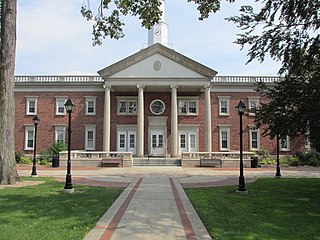
Windsor is a town in Hartford County, Connecticut, United States, and was the first English settlement in the state. It lies on the northern border of Connecticut's capital, Hartford. The town is part of the Capitol Planning Region. The population of Windsor was 29,492 at the 2020 census.

Barkhamsted is a town in Litchfield County, Connecticut, United States. It contains seven villages: West Hill, Mallory, Barkhamsted Center, Center Hill, Washington Hill, Pleasant Valley, and Riverton. The population was 3,647 at the 2020 census, down from 3,799 at the 2010 census. The town is part of the Northwest Hills Planning Region. Barkhamsted was first incorporated in 1779, and named after Berkhamsted, Hertfordshire, England.

Barkhamsted Hollow was a village in northwestern Connecticut. It was part of the town of Barkhamsted, Connecticut in Litchfield County, Connecticut, incorporated as part of Barkhamsted in 1779. It was flooded by the creation of the Barkhamsted Reservoir in 1940, splitting Barkhamsted and the nearby town of Hartland, Connecticut in half.

The Farmington River is a river, 46.7 miles (75.2 km) in length along its main stem, located in northwest Connecticut with major tributaries extending into southwest Massachusetts. The longest route of the river, from the origin of its West Branch, is 80.4 miles (129.4 km) long, making it the Connecticut River's longest tributary by 2.3 miles (3.7 km) over the major river directly to its north, the Westfield River. The Farmington River's watershed covers 609 square miles (1,580 km2). Historically, the river played an important role in small-scale manufacturing in towns along its course, but it is now mainly used for recreation and drinking water.
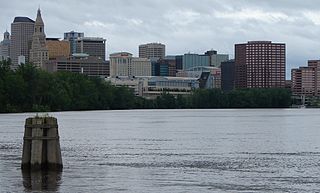
Greater Hartford is a region located in the U.S. state of Connecticut, centered on the state's capital of Hartford. It represents the only combined statistical area in Connecticut defined by a city within the state, being bordered by the Greater Boston region to the northeast and New York metropolitan area to the south and west. Sitting at the southern end of the Metacomet Ridge, its geology is characterized by land of a level grade along the shores of Connecticut River Valley, with loamy, finer-grained soil than other regions in the state. Greater Hartford, had a total population of 1,213,531 at the 2020 United States census.

CT Transit is a public transportation bus system serving many metropolitan areas and their surrounding suburbs in the state of Connecticut. CT Transit is a division of the Connecticut Department of Transportation, although it contracts a number of private companies for most of its operations. CT Transit began operations in 1976 as Connecticut Transit after the Connecticut DOT's acquisition of the Connecticut Company. Initially serving only the Hartford, New Haven, and Stamford areas, CT Transit's service now extends throughout much of Connecticut. CT Transit provides local "city bus" service in Bristol, Hartford, Meriden, New Britain, New Haven, Stamford, Wallingford and Waterbury in addition to a number of express routes connecting to outlying suburbs and other regions of the state.

WSDK is a commercial AM radio station licensed to Bloomfield, Connecticut, and serving the Hartford metropolitan area. It is owned by Blount Communications and broadcasts a Christian talk and teaching radio format. National religious leaders heard on WSDK include Chuck Swindoll, John Daly, June Hunt, David Jeremiah and John MacArthur. WSDK uses a brokered programming plan, where hosts pay for time on the station and they may use their shows to seek donations to their ministries.

The Nepaug River begins at the confluence of North Nepaug Brook and Cedar Swamp Brook about one mile (1.6 km) east of Bakerville, Connecticut.
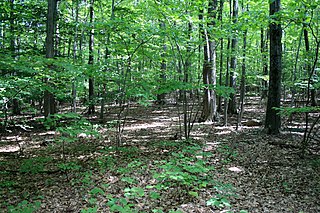
The West Hartford Reservoir recreation area is located on the western edge of West Hartford, Connecticut and 2.5 miles (4.0 km) northeast of Farmington, Connecticut. There are six large reservoirs along the eastern part of the park and a paved cycling trail that winds through the southern portion. The blue-blazed Metacomet Trail follows the highest ridge of the area and the network of trails throughout the area has led this to be a local mecca for mountain bikers, hikers, and trail-runners. The western edge is marked by Deer Cliff, a high rocky ledge that runs for about 1.5 miles (2.4 km) north-south. The Deer Cliff ledges have a long tradition of climbing routes for local mountaineers, but at this time the private access to the cliff base has been closed to the public. The Revolutionary War Campsite historical site is located near reservoir #6.

Talcott Mountain of central Connecticut, with a high point of 950 feet (290 m), is a 13-mile (21 km) long trap rock mountain ridge located 6 miles (10 km) west of the city of Hartford. The ridge, a prominent landscape feature, forms a continuous line of exposed western cliffs visible across the Farmington River valley from Farmington to Simsbury. Talcott Mountain is part of the narrow, linear Metacomet Ridge that extends from Long Island Sound near New Haven, Connecticut, north through the Connecticut River Valley of Massachusetts to the Vermont border.

Saville Dam is an earthen embankment dam with masonry work on the eastern branch of the Farmington River in southwestern Barkhamsted, Connecticut and central Hartland, Connecticut, dividing the latter into two villages along its hilltops, East and West Hartland. The dam is 135 ft. tall and 1,950 ft. long and has an uncontrolled spillway on its western portion. It creates the Barkhamsted Reservoir which has a volume of 36.8 billion US gallons (139,000,000 m3) and is the primary water source for Hartford, Connecticut. Connecticut Route 318, also known as Saville Dam Road, crosses over the top of the dam.
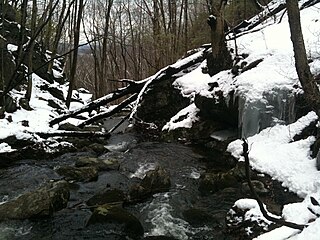
The Tunxis Trail is a 79-mile (127 km) Blue-Blazed hiking trail "system" that traverses the western ridge of the central Connecticut Valley. The mainline trail is not completely contiguous, notably there are two gaps of several miles.
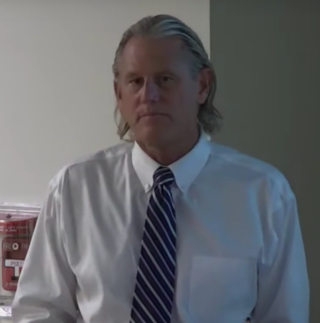
Kevin Witkos is a Republican member of the Connecticut State Senate, representing the 8th District since 2009. He served as Deputy Senate Republican President Pro Tempore since January 2017 to January 2019. and previously served as Minority Leader Pro Tempore from 2014 to 2016 and Caucus Chairman for Outreach since 2013. Witkos served as the State Representative from the 17th district which includes Canton and part of Avon from 2003 to 2008.
William A. DiBella is a Connecticut politician and businessman who has served as chairman of the board at the Metropolitan District Commission of Connecticut since 2002, a post he previously held from 1977 to 1981. DiBella is currently a lobbyist, and a Principal at CMD Ventures LLC., a company which specializes in real estate management and property development.
Shawn T. Wooden is an American attorney and politician who served as the state treasurer of Connecticut between January 2019 and January 2023. Wooden previously served as a member of the Hartford City Council.
Shari Cantor is a Certified Public Accountant and politician from West Hartford, Connecticut. She is the Mayor of West Hartford.
Tammy R. Exum is a teacher and politician from Connecticut. She is a member of the Connecticut House of Representatives since 2019, when she won the special election. Formerly, she was a member and later the Vice Chair of the West Hartford, Connecticut Board of Education. She was also very active in the school community working the PTA and more. She is a member of the Democratic Party.




















